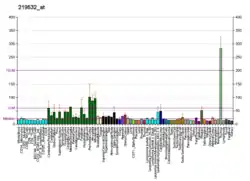ELOVL4
Elongation of very long chain fatty acids protein 4 is a protein that in humans is encoded by the ELOVL4 gene.[5][6]
See also
References
- GRCh38: Ensembl release 89: ENSG00000118402 - Ensembl, May 2017
- GRCm38: Ensembl release 89: ENSMUSG00000032262 - Ensembl, May 2017
- "Human PubMed Reference:". National Center for Biotechnology Information, U.S. National Library of Medicine.
- "Mouse PubMed Reference:". National Center for Biotechnology Information, U.S. National Library of Medicine.
- Zhang K, Kniazeva M, Han M, Li W, Yu Z, Yang Z, Li Y, Metzker ML, Allikmets R, Zack DJ, Kakuk LE, Lagali PS, Wong PW, MacDonald IM, Sieving PA, Figueroa DJ, Austin CP, Gould RJ, Ayyagari R, Petrukhin K (Jan 2001). "A 5-bp deletion in ELOVL4 is associated with two related forms of autosomal dominant macular dystrophy". Nat Genet. 27 (1): 89–93. doi:10.1038/83817. PMID 11138005. S2CID 23672516.
- "Entrez Gene: ELOVL4 elongation of very long chain fatty acids (FEN1/Elo2, SUR4/Elo3, yeast)-like 4".
Further reading
- Zhang K, Bither PP, Park R, et al. (1994). "A dominant Stargardt's macular dystrophy locus maps to chromosome 13q34". Arch. Ophthalmol. 112 (6): 759–64. doi:10.1001/archopht.1994.01090180057035. PMID 8002833.
- Stone EM, Nichols BE, Kimura AE, et al. (1994). "Clinical features of a Stargardt-like dominant progressive macular dystrophy with genetic linkage to chromosome 6q". Arch. Ophthalmol. 112 (6): 765–72. doi:10.1001/archopht.1994.01090180063036. PMID 8002834.
- Edwards AO, Miedziak A, Vrabec T, et al. (1999). "Autosomal dominant Stargardt-like macular dystrophy: I. Clinical characterization, longitudinal follow-up, and evidence for a common ancestry in families linked to chromosome 6q14". Am. J. Ophthalmol. 127 (4): 426–35. doi:10.1016/S0002-9394(98)00331-6. PMID 10218695.
- Li Y, Marcos I, Borrego S, et al. (2001). "Evaluation of the ELOVL4 gene in families with retinitis pigmentosa linked to the RP25 locus". J. Med. Genet. 38 (7): 478–80. doi:10.1136/jmg.38.7.478. PMC 1757187. PMID 11474659.
- Edwards AO, Donoso LA, Ritter R (2001). "A novel gene for autosomal dominant Stargardt-like macular dystrophy with homology to the SUR4 protein family". Invest. Ophthalmol. Vis. Sci. 42 (11): 2652–63. PMID 11581213.
- Strausberg RL, Feingold EA, Grouse LH, et al. (2003). "Generation and initial analysis of more than 15,000 full-length human and mouse cDNA sequences". Proc. Natl. Acad. Sci. U.S.A. 99 (26): 16899–903. doi:10.1073/pnas.242603899. PMC 139241. PMID 12477932.
- Rivolta C, Ayyagari R, Sieving PA, et al. (2003). "Evaluation of the ELOVL4 gene in patients with autosomal recessive retinitis pigmentosa and Leber congenital amaurosis". Mol. Vis. 9: 49–51. PMID 12592226.
- Lagali PS, Liu J, Ambasudhan R, et al. (2003). "Evolutionarily conserved ELOVL4 gene expression in the vertebrate retina". Invest. Ophthalmol. Vis. Sci. 44 (7): 2841–50. doi:10.1167/iovs.02-0991. PMID 12824221.
- Vrabec TR, Tantri A, Edwards A, et al. (2003). "Autosomal dominant Stargardt-like macular dystrophy: identification of a new family with a mutation in the ELOVL4 gene". Am. J. Ophthalmol. 136 (3): 542–5. doi:10.1016/S0002-9394(03)00227-7. PMID 12967813.
- Mungall AJ, Palmer SA, Sims SK, et al. (2003). "The DNA sequence and analysis of human chromosome 6". Nature. 425 (6960): 805–11. Bibcode:2003Natur.425..805M. doi:10.1038/nature02055. PMID 14574404.
- Ota T, Suzuki Y, Nishikawa T, et al. (2004). "Complete sequencing and characterization of 21,243 full-length human cDNAs". Nat. Genet. 36 (1): 40–5. doi:10.1038/ng1285. PMID 14702039.
- Ambasudhan R, Wang X, Jablonski MM, et al. (2004). "Atrophic macular degeneration mutations in ELOVL4 result in the intracellular misrouting of the protein". Genomics. 83 (4): 615–25. doi:10.1016/j.ygeno.2003.10.004. PMID 15028284.
- Gerhard DS, Wagner L, Feingold EA, et al. (2004). "The Status, Quality, and Expansion of the NIH Full-Length cDNA Project: The Mammalian Gene Collection (MGC)". Genome Res. 14 (10B): 2121–7. doi:10.1101/gr.2596504. PMC 528928. PMID 15489334.
- Grayson C, Molday RS (2005). "Dominant negative mechanism underlies autosomal dominant Stargardt-like macular dystrophy linked to mutations in ELOVL4". J. Biol. Chem. 280 (37): 32521–30. doi:10.1074/jbc.M503411200. PMID 16036915.
- Lai Z, Zhang XN, Zhou W, et al. (2006). "Evaluation of the ELOVL4 gene in a Chinese family with autosomal dominant STGD3-like macular dystrophy". J. Cell. Mol. Med. 9 (4): 961–5. doi:10.1111/j.1582-4934.2005.tb00392.x. PMC 6740257. PMID 16364203.
- Hubbard AF, Askew EW, Singh N, et al. (2006). "Association of adipose and red blood cell lipids with severity of dominant Stargardt macular dystrophy (STGD3) secondary to an ELOVL4 mutation". Arch. Ophthalmol. 124 (2): 257–63. doi:10.1001/archopht.124.2.257. PMID 16476896.
- Seitsonen S, Lemmelä S, Holopainen J, et al. (2006). "Analysis of variants in the complement factor H, the elongation of very long chain fatty acids-like 4 and the hemicentin 1 genes of age-related macular degeneration in the Finnish population". Mol. Vis. 12: 796–801. PMID 16885922.
- McMahon A, Butovich IA, Mata NL, et al. (2007). "Retinal pathology and skin barrier defect in mice carrying a Stargardt disease-3 mutation in elongase of very long chain fatty acids-4". Mol. Vis. 13: 258–72. PMC 2633486. PMID 17356513.
This article is issued from Wikipedia. The text is licensed under Creative Commons - Attribution - Sharealike. Additional terms may apply for the media files.




